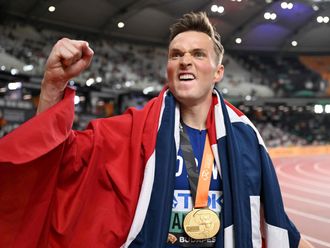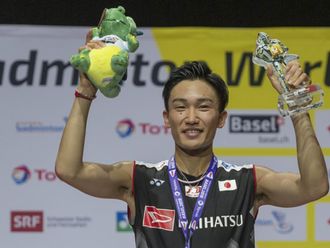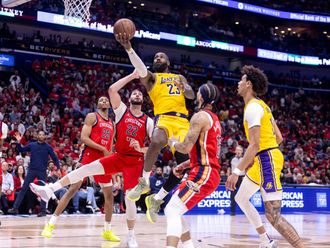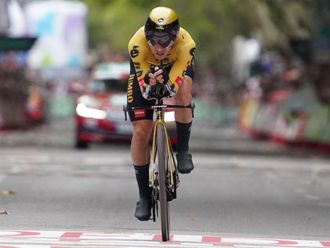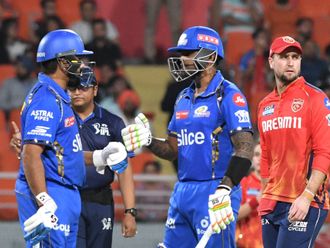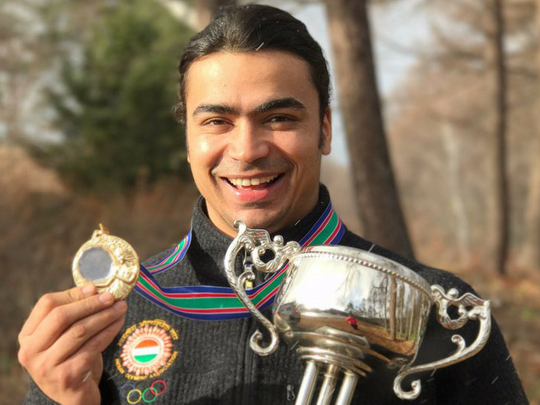
London: Imagine hurtling down a frozen, concrete chute at 130 kilometres an hour feet first on a sled without brakes – while being subjected to more g-force than an astronaut is during a rocket launch.
Then, consider doing this for 20 years with minimal funding and outmoded equipment – and still being on the cusp of appearing at your sixth Winter Olympics.
That’s the Herculean achievement of India’s Shiva Keshavan, who is preparing to compete in luge at the 2018 Games in Pyeongchang, South Korea.
Keshavan and the cross-country skier, Jagdish Singh, are the only Indians set to participate in the global extravaganza, which begins next Friday.
It will be the 36-year-old’s final Olympic appearance, given that he feels it is no longer “feasible” to continue financially with a wife and young daughter to support.
Yet the doughty Keshavan is determined to bow out in style as a bona-fide sporting trailblazer for his country, he tells Gulf News.
“I am absolutely very proud,” he says of the prospect of being one behind tennis legend Leander Paes’s record of seven Olympic appearances (all at the summer Games) for India. “It wasn’t ever a goal for me, but it just happened one step at a time. Leander is a big inspiration, not just for all that he’s achieved, but I’ve met him and he’s a very inspiring guy. And at his age [44], he’s still performing at a high level.”
The seeds for Keshavan’s Olympic odyssey were sowed in his hometown of Manali in the Himalayas in northern India – fertile territory for winter sports. A talented skier, his potential for luge was spotted during an International Luge Federation scouting session to boost the worldwide development of the sport.
Keshavan went to Austria to train and, a year later in 1998, aged only 16, he became the youngest-ever Olympic luge athlete at the Nagano Winter Games. The first Indian to compete in luge, he came 28th – despite having to wear an oversized, borrowed jacket and use a hand-me-down sled.
Keshavan finished 33rd four years later in Salt Lake City in 2002, 25th at Turin in 2006, 29th at Vancouver in 2010 and 37th at Sochi four winters ago.
At first glance, such results seem wholly unremarkable – especially since he was between five and 10 seconds behind the gold medallists. Yet, given his myriad struggles, it is extraordinary that Keshavan reached the start lines at all.
“Of course, there have been many hard times,” says Keshavan, who speaks effervescently throughout, even when elucidating the hardships he has endured. “Sometimes it wasn’t [about] me feeling like giving up, but I couldn’t even go and compete and train as I didn’t have the money to. I used to hitch a ride with [athletes from] other countries and their sled transport vehicles and I slept in my car for some World Cups because of the cost of travel.
“I’ve not been able to participate in as many races and trainings as I should have and also it’s pretty expensive to have the latest equipment and often I’ve had to make my own sled or use hand-me-downs.
“It takes so much of your physical and mental space that you’re not really 100 per cent concentrating on what you should as an athlete. In India, we don’t have a luge track, so how do you train? We came up with a modification to the sleds in which you can have rollerblades so you can go down roads.”
Most people would have given up when faced with such relentless adversity, but Keshavan’s exceptional passion, positivity, drive and determination have seen him plough on regardless.
“I could have sat and complained about it or I could try and find ways to make [things] happen. Every year I’ve had to go out and apply to the government for various means of sustaining this. I’ve gone out and spoken to corporates and done online fund-raising campaigns – all kinds of ways in which I could be active in the sport.
“I just love the whole thing about performing at high speed in extreme conditions. It might seem like, for someone who doesn’t know much about the sport, an adrenalin-centred sport. It’s not really like that because once you do many runs, it’s not about the thrill which you’re seeking down the track, but more about how you’re trying to relax your mind and body in extreme conditions.”
He stresses that the unstinting support of his friends, family and fans – he receives a lot of letters of encouragement from “random people” – has sustained him during hard times.
Likewise, he cherishes “the relationships I have built with athletes all over the world”.
“A lot of people get inspired by the struggle, by the journey I’ve had,” says Keshavan, who reveals his goal for his Olympic swansong – which begins with heats on February 10 – is a career-best performance. “If I have doubts, then I know that I am doing something that is bigger than just myself.”
That ‘something’ is an laudably altruistic ambition to leave a legacy for others like him.
“Now I am a known face for winter sports and luge [in India], I’ve been able to open some doors,” he continues, after finishing training in Austria despite having sustained two hairline fractures in his right hand following a crash in Germany. “This year, for the first time, the [Indian] government nominated me as an elite-level athlete – the first time any winter sports athlete in India has been nominated for the Target Olympic Podium (TOP) scheme. It shows that the government is looking at non-mainstream sports. It can set a precedent.”
“One of the things I am trying to do in India is to get more athletes involved in sports administration because I think that’s one of the handicaps we have,” adds Keshavan, who has no firm retirement plans yet. “Most of our sports administrators don’t have a [sporting] background and often don’t understand what is required for a long-term programme and plan to perform.
“I started the Olympians’ Association of India that brings a lot of the Indians together and everyone can contribute to the Olympic committee and sports in India. We’re doing a lot of programmes such as academies and education, skill development, trying to get insurance and also advising the government on things to do.
“I’ve been in contact with a lot of Olympians through this and have met Leander [Paes] on several occasions because we have a few records in sports that we share. We even had a conversation about making a bobsleigh team once [laughs]. I’m not sure that’s going to happen, but it’s always fun to learn and share experiences with other athletes like him.”
Could Keshavan yet reverse his decision to retire, like the legendary British rower and Olympian, Sir Steve Redgrave, so momentously did?
Redgrave declared that, “Anyone who sees me in a boat has my permission to shoot me”, after winning his fourth Olympic gold medal in 1996 – only to change his mind and go on to claim his fifth four years later.
“Never say never, let’s see what happens,” the irrepressible Keshavan says of the prospect of him performing a similar U-turn.
*The author is a sports journalist in the United Kingdom
FACTFILE
Name: Shiva Keshavan
Date of birth: August 25, 1981 (Age 36)
Place of birth: Manali, Himachal Pradesh, India
Notable achievements:
• Youngest person to qualify for the Olympics in luge aged 16 in 1998
• First Indian to compete in luge
• Asian Luge Cup, gold medal: 2011, 2012, 2017; silver medal: 2009, 2013, 2014, 2015; bronze medal: 2005, 2008
• Asian speed record-holder: 134.3km/h (83.5mph)
• Arjuna Award, Government of India: nominee, 2012
• Parshuram Award, Government of Himachal Pradesh: nominee, 2012
Website: http://www.shivakeshavan.in/
Twitter handle: @100thofasec


